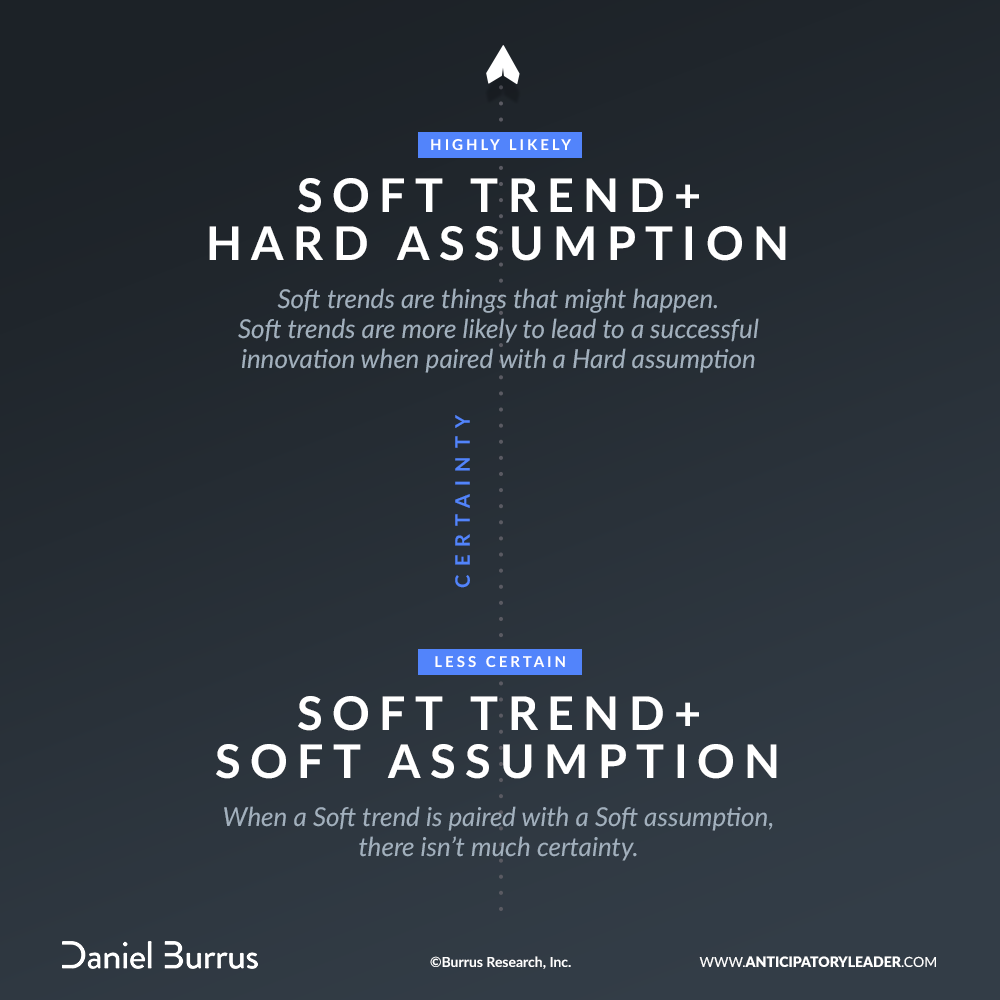One thing is for certain: the future is uncertain.
But within that uncertainty lies immense potential for growth and innovation. This is only for those who can find the certainty that comes with it. By leveraging Hard Trends and Soft Trends, you can discover what you know for sure will happen, locating the opportunity within uncertainty and disruption.
Traditional business strategies often focus on reacting to changes after they occur. But what if organizations could shape those changes before they happen? This is the promise of strategic innovation, which redefines how value is created and delivered.
However, the “strategy” part of innovation lies in anticipating what we know for certain and what we have the power to change.
Unlike Hard Trends, which are inevitable future facts, Soft Trends can be influenced, offering organizations a unique chance to shape their industries and define their trajectories. Soft Trends being future possibilities that can be shaped makes them a powerful tool for businesses looking to leverage strategic innovation efforts.
By blending innovative strategies with foresight, organizations can remain competitive and even disrupt entire industries. Let’s explore how Soft Trends can be identified and influenced, as they play a critical role in reshaping industries, achieving long-term growth, and fostering innovation initiatives.
What Is Strategic Innovation and Why It Matters?
Strategic innovation involves breaking away from traditional business models to identify untapped opportunities. Unlike incremental improvements, which refine existing processes, strategic innovation delivers transformative solutions that redefine entire industries.
This type of innovation thrives on anticipation and proactive planning. It helps businesses avoid becoming reactionary, only responding to someone else’s innovation efforts.
The importance of strategic innovation lies in its ability to:
- Adapt to Disruption: Industries face constant change, driven by exponential technological growth and shifting consumer demands.
- Create New Value: By addressing unmet needs or redefining market norms, companies can unlock unique opportunities.
- Sustain Relevance: Organizations that fail to innovate risk falling behind in competitive markets.
To stay ahead, businesses must first differentiate between Hard Trends and Soft Trends. Hard Trends are certainties and in contrast, Soft Trends provide a canvas for creative influence and action in strategic innovation.
The Difference Between Hard Trends and Soft Trends
With over 30 years of experience as a global futurist and business consultant, I have frequently highlighted the importance of my Hard Trend Methodology in driving effective strategic innovation processes.
Founded on both Hard Trends and Soft Trends, understanding this methodology and the distinction between the two is an essential first step to companies looking to not only foster an innovative culture but also drive business growth and become a positive disruptor in their industry.
Hard Trends: Certainties to Plan Around
Hard trends are predictable future certainties. They act as a metaphorical compass that guides you through times of extreme uncertainty, pointing directly at the evidence of what you can be certain about by highlighting what will continue. Hard Trends are grounded in data or observable patterns. For example:
- Technology: Increasing AI adoption in industries like healthcare and finance.
- Demographics: The aging Baby Boomer population will require more healthcare services.
- Regulation: Governments worldwide are enacting stricter data privacy laws.

The success story of Hard Trends is that they allow businesses to anticipate disruptions and create strategic innovation plans with confidence. For instance, companies leveraging the Hard Trend of continued and increasing smartphone adoption have designed apps to simplify banking, retail, and healthcare.
Soft Trends: Possibilities to Influence
Soft trends are future maybes. They may or may not happen, but they are open to influence. Soft Trends emerge from assumptions or behaviors that can change depending on actions taken today. For example:
- Consumer Preferences: A growing preference for plant-based diets is a Soft Trend. While it’s gaining momentum, its future depends on continued advocacy, education, and product innovation.
- Workplace Dynamics: Predictions about hybrid work models are Soft Trends, as they rely on cultural adoption and leadership decisions.
I have taught this concept for many years, but every year brings new business leaders who do not grasp the disruptive power of Soft Trends. Their beauty lies in their potential for influence by way of innovation initiatives.
Unlike Hard Trends, they aren’t fixed and can be altered to fit strategic goals. This means that organizations that learn to shape Soft Trends can transform them into a competitive advantage.
Why Are Soft Trends Critical for Strategic Innovation?
Soft Trends are particularly valuable because they represent real opportunities for innovation initiatives and long-term success. Companies that engage with Soft Trends proactively can:
- Influence Markets: By steering trends toward favorable outcomes, businesses can shape their industries to their advantage.
- Capture Emerging Opportunities: In a rapidly changing business environment, Soft Trends often signal new areas for strategic innovation, from customer engagement strategies to product design and harnessing emerging technologies.
- Mitigate Risks: Understanding and influencing Soft Trends enables companies to pivot before challenges escalate.
Consider these real-world examples:
- Retail Industry Transformation: The rise in e-commerce was once a Soft Trend. Early adopters, like Amazon who began with only an online bookstore, turned this possibility into a certainty, revolutionizing the way people shop.
- The Telehealth Revolution: The growing interest in virtual healthcare began as a Soft Trend. However, during the COVID-19 pandemic, strategic innovators used technological advancements to develop user-friendly platforms, turning telehealth into a primary mode of care.

Steps to Leverage Soft Trends for Innovation Initiatives
With the speed of technology change and market disruptions in today’s fast-paced world, staying ahead of the competition requires more than just agility. It demands foresight, and Soft Trends provide businesses with a unique opportunity: the ability to shape the future rather than react to it. But how can you as a business leader leverage Soft Trends effectively?
1. Identify Emerging Trends in Your Industry
Soft Trends often emerge from shifting consumer preferences, societal changes, or technological innovations. Keep an eye on patterns that signal potential changes.
- Example: The increasing focus on sustainability in packaging. Companies that adopt eco-friendly practices now are positioning themselves as leaders in a greener future.
2. Analyze Underlying Assumptions
Distinguish between Hard Assumptions and Soft Assumptions:
- Hard Assumptions are backed by data. For instance, the increasing availability of wearable health devices is supported by market growth data.
- Soft Assumptions are based on intuition or untested beliefs, such as predicting a new app will go viral.

3. Collaborate Across Ecosystems
Soft Trends are often shaped collectively. What may be obvious to someone else may not be obvious to you. Encourage collaboration across business teams, encourage collaboration across departments, and even across industries.
- Example: In the automotive industry, partnerships between tech firms and automakers have driven the adoption of autonomous vehicles, which began as a Soft Trend.
4. Experiment with Prototypes and Pilots
Use Soft Trends as a testing ground for innovation. Launch small-scale initiatives to explore feasibility and refine approaches.

Example: Instagram started as a location-based check-in app called Burbn. Realizing it was too similar to Foursquare, the founders refocused the app on photo-sharing, which had become a popular feature among its users. They renamed it Instagram, a blend of the words “instant camera” and “telegram.” By aligning with the rising trend of social photo-sharing, Instagram capitalized on this opportunity and became a household name. Today, Instagram is worth an estimated $100 billion, exemplifying the power of leveraging Soft Trends to identify and scale transformative opportunities.
5. Evaluate and Refine
Success in applying strategic innovation lies in continuous improvement and refinement. As the future unfolds and new insights come to light, refine your strategies according to market trends, customer insights, and technology shifts.
Case Studies: Successful Companies Employing Strategic Innovation
Case Study 1: Peloton and At-Home Fitness
Before 2020, Peloton identified the Soft Trend of growing interest in convenient, at-home fitness experiences. Consumers wanted to be fit, but also didn’t want to take the time to go to the gym. They capitalized on this trend by creating a fitness ecosystem that combined high-quality equipment, live-streamed classes, and a community-driven experience.

This positioned Peloton as a leader during a time when gyms became inaccessible.
Case Study 2: Tesla’s Electric Vehicle Adoption
Electric vehicles were once a niche market, with a Soft Trend toward sustainability-driven transportation. Tesla identified this trend as an opportunity and influenced its trajectory by focusing on high-performance EVs with an extensive charging infrastructure.

This both increased EV adoption as well as positioned Tesla as an industry leader.
How Soft Trends Can Help Pre-Solve Problems
Anticipating problems before they occur is a hallmark of strategic innovation as well as my Anticipatory Organization® Model. Soft Trends, as well as Hard Trends, have the ability to highlight potential challenges and provide the insights needed to pre-solve problems before they have the opportunity to disrupt business processes.
Examples of Pre-Solved Problems:
- Workforce Retention: Companies anticipating the difficulty of retaining talent have invested in upskilling and flexible work policies, addressing the trend before it becomes a crisis.
- Supply Chain Risks: Businesses monitoring geopolitical trends have diversified suppliers to minimize disruptions.
Sustaining Strategic Innovation Through Soft Trends
1. Foster a Culture of Foresight
As much as we may wish it, Soft Trends don’t materialize of thin air. They are always there, yes, but recognizing them and influencing them to create a strategic advantage for your business requires a company-wide culture of Anticipation.
An organization’s process of reinventing the status quo begins by establishing an innovative culture where employees at all levels feel encouraged to look to the future and contribute their skills and expertise to recognizing insights about emerging trends. This type of culture involves encouraging collaboration across all departments and all levels, where business leaders provide necessary support that empowers employees to contribute new ideas and challenge the status quo.
2. Invest in Ongoing Education
Continuous learning is no longer optional—it’s essential.
The world we live in is transforming at exponential rates, with AI leading the charge of the new Industrial Revolution. To remain competitive, organizations must ensure their teams are equipped to adapt to emerging trends and capitalize on future opportunities. This involves not only staying updated on industry developments but also cultivating an Anticipatory Mindset when it comes to change, enabling employees to anticipate change rather than react to it.
3. Leverage Advanced Analytics
Advanced analytics, powered by AI and machine learning, is transforming how organizations monitor and act on Soft Trends. Predictive analytics allows businesses to sift through vast amounts of data in real time, identifying patterns and trends that might otherwise go unnoticed. This enables leaders to make informed decisions faster, reducing risks and uncovering opportunities ahead of competitors.
Integrating a systematic approach to analytics allows businesses to:
- Monitor customer behavior with precision.
- Track market dynamics and operational efficiencies.
- Leverage tools like predictive models and sentiment analysis for actionable insights.

These insights empower businesses to shape Soft Trends proactively, ensuring alignment with evolving market demands and fostering strategic innovation.
A Call to Action: Turn Trends into Transformative and Successful Strategic Innovation
Seize the opportunity to lead, not follow. Soft Trends empower you to proactively shape the future, setting new standards in innovation and influence. By adopting an Anticipatory Mindset and integrating it into your strategy, you position your organization to capitalize on emerging opportunities and stay ahead of the competition.
Don’t wait for change to define you—embrace it, shape it, and lead the charge toward a transformative future. Download Daniel Burrus’ Top 25 Tech Trend Report for 2025 and discover how you can harness the trends that will define tomorrow’s success.